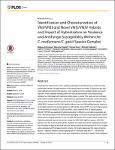Identification and Characterization of VNI/VNII and Novel VNII/VNIV Hybrids and Impact of Hybridization on Virulence and Antifungal Susceptibility Within the C. neoformans/C. gattii Species Complex
Aminnejad, Mojgan
Cogliati, Massimo
Duan, Shuyao
Arabatzis, Michael
Tintelnot, Kathrin
Castañeda, Elizabeth
Lazéra, Marcia
Velegraki, Aristea
Ellis, David
Sorrell, Tania C.
Meyer, Wieland
Cryptococcus neoformans and C. gattii are pathogenic basidiomycetous yeasts and the commonest cause of fungal infection of the central nervous system. Cryptococci are typically haploid but several inter-species, inter-varietal and intra-varietal hybrids have been reported. It has a bipolar mating system with sexual reproduction occurring normally between two individuals with opposite mating types, α and a. This study set out to characterize hybrid isolates within the C. neoformans/C. gattii species complex: seven unisexual mating intra-varietal VNI/VNII (αAAα) and six novel inter-varietal VNII/VNIV (aADα). The URA5-RFLP pattern for VNII/VNIV (aADα) differs from the VNIII (αADa) hybrids. Analysis of the allelic patterns of selected genes for AD hybrids showed 79% or more heterozygosis for the studied loci except for CBS132 (VNIII), which showed 50% of heterozygosity. MALDI-TOF MS was applied to hybrids belonging to different sero/mating type allelic patterns. All hybrid isolates were identified as belonging to the same hybrid group with identification scores ranging between 2.101 to 2.634. All hybrids were virulent when tested in the Galleria mellonella (wax moth) model, except for VNII/VNIV (aADα) hybrids. VNI/VGII hybrids were the most virulent hybrids. Hybrids recovered from larvae manifested a significant increase in capsule and total cell size and produced a low proportion (5–10%) of giant cells compared with the haploid control strains. All strains expressed the major virulence factors—capsule, melanin and phospholipase B—and grew well at 37°C. The minimal inhibitory concentration of nine drugs was measured by micro-broth dilution and compared with published data on haploid strains. MICs were similar amongst hybrids and haploid parental strains. This is the first study reporting natural same sex αAAα intra-varietal VNI/VNII hybrids and aADα inter-varietal VNII/VNIV hybrids.
No license information

